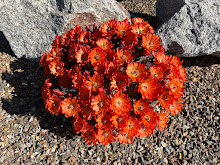It would be a little difficult for you to ascertain the size of this botanical object without anything alongside to give you some perspective. It is actually 5" long and if you were to shake it you might think it was a rattle. Any idea?
You won't find it growing in my Texas garden. In fact this pod fell or was picked off the tree some time in 1941. That was when my father, who was stationed in Southern Rhodesia during WW2, (Zimbabwe in today's world), picked it up. It went back with him to England in his kit, along with some simple native wood carvings. It went to show and tell with me, when I was a little girl, and 3 years ago it sailed across the Atlantic and ended up in Texas. Why would I keep such an item? Who knows.
This is what it might have looked like when it was on the tree.
And this is what it would have looked like if it had chance to ripen. Those white coated seeds in the center are cocoa beans. Who would have thought.
I wasn't in Africa when I photographed this pod. I was on a mountain biking ride in St Lucia. We actually tasted the flesh around the seeds. It had a familiar taste not unlike cherimoya.
It was an interesting bike ride for a gardener whose eyes were glued to the flowers and foliage rather than the path.
We stopped again to look at a nutmeg tree.( I have a few nutmegs that I have had for at least 20 years). They are still fragrant when grated. That red lace-like covering over the nutmeg is mace. Dried and ground it has a more delicate flavor than nutmeg but like nutmeg is used to flavor potato dishes, baked goods and mulled wine.
The flowers on this tree will eventually produce coffee berries.
Can you guess the name of this fruit?
This is the ripe fruit growing on a small evergreen tree.
The yellow pear shaped structure is not the true fruit. The kidney shaped drupe growing at the bottom of the pear is the true fruit and contains one seed which is encapsulated in a hard double shell. The shell contains an allergenic phenolic resin called anacardic acid which must be removed by roasting. Because the smoke from the roasting is irritating to the lungs, roasting must be done outside.
Doesn't this give you a new appreciation for the cashew nut? No wonder they are so expensive.
Subscribe to:
Post Comments (Atom)



































10 comments:
Fascinating! I love the polished old-wood look of the pod in the first photo.
How interesting to see one of my favorite foods (that would be chocolate!) in its growing phase, and how sad that I've never thought to look it up. Thanks for sharing!
Great collection of photos, memories and interesting information!
Ciekawe owoce ,,, to chyba była wspaniała i pouczająca wycieczka ...
pozdrawiam
Very interesting post- for the record... I did not guess one thing! hahaha
That was an interesting post! I've studied tropical fruits, but still it always amazes me to see them again. I still can't believe s SINGLE cashew is produced in that fruit. Yes, they are expensive for good reason.
BTW: I really don't have a pet oppossum. It hangs around WANTING to be the guest resident of my garden, but that's where the relationship stops. LOL
I need to trap him and his friend and send them out to a big park west of town.
David/ :-)
All new to me, and so exciting - might need a helmet walking in tropical forests! But mountain biking brings one automatically!
The cashew - even more amazing!
Fascinating, amazing and educational - all in one go! I didn't guess anything, either.
Barbara H.
Great post! Love the history of that old pod. Everything else too. And the cashew! I would have never known.
Very interesting. The only one I knew about was the nutmeg and mace. I do indeed have a new appreciation for cashews now!
Post a Comment